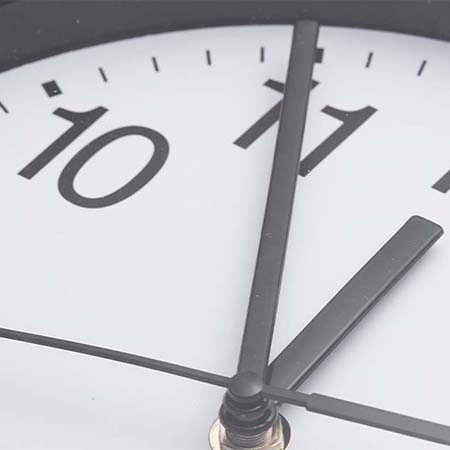![]() Our site is no longer compatible with Internet Explorer
Our site is no longer compatible with Internet Explorer
Heartlandamerica.com is best experienced using:

Please click the link below to download
Daylight Saving 2025: History, Benefits & Drawbacks
Learn more about daylight saving time in the United States and when to set your clocks forward in 2024!
by Jessie Breheim • March 02, 2023
Daylight saving time (DST) is a seasonal practice in which clocks are adjusted forward by one hour during the summer months and then back again by one hour during the winter months. This adjustment results in longer evenings and shorter mornings during the summer, and shorter evenings and longer mornings during the winter. The practice of daylight saving time is observed by more than 70 countries worldwide, with the exception of some areas such as Hawaii, Puerto Rico, and most of Arizona in the United States. While the purpose of DST was originally intended to save energy and increase productivity, the effects and benefits of this practice are still debated today.

History of Daylight Saving Time
The idea of daylight saving time can be traced back to Benjamin Franklin, who first suggested the concept in a satirical essay in 1784. However, the modern implementation of DST can be attributed to New Zealand entomologist George Vernon Hudson, who proposed the idea in 1895 to allow for more daylight during his leisure time.
During World War I, many countries implemented DST as a way to conserve fuel for the war effort. The practice was temporarily abolished after the war but reinstated during World War II. In the United States, DST was standardized in 1966 with the Uniform Time Act, which established a nationwide system of switching clocks forward in the spring and back in the fall.
Advantages of Daylight-Saving Time
One of the primary benefits of daylight saving time is that it can lead to energy savings. Longer daylight hours during the summer months mean that people are less likely to need to turn on their lights in the evening, which can reduce energy consumption. Additionally, the practice of DST can reduce traffic accidents and crime rates since there is more daylight during peak commuting and activity hours.
DST can also provide economic benefits, particularly for businesses in the retail and tourism sectors. Longer daylight hours mean that people are more likely to spend time outside and participate in leisure activities, which can stimulate the economy. Additionally, the practice of DST can align business hours with daylight hours, making it easier for people to shop and engage in commercial activities.

Disadvantages of Daylight Saving Time
While there are several benefits to daylight saving time, there are also some potential disadvantages to consider. One of the primary concerns is that the practice can disrupt people's sleep patterns and circadian rhythms. Adjusting clocks forward by one hour in the spring can lead to a loss of sleep and can take several days to adjust. Additionally, some studies suggest that DST may increase the risk of heart attacks and other health problems.
Another potential disadvantage of daylight saving time is that it can lead to confusion and inconvenience. Changing clocks twice a year can be a hassle, and it can be difficult to remember which way to adjust the clock. Additionally, the practice of DST is not universally observed, which can create confusion for people who travel or do business across time zones.

Daylight Saving Time
In the United States, Daylight Saving Time (DST) begins on Sunday, March 9, 2025. at 2:00 AM Clocks should be set forward by one hour at this time, meaning that 2:00 AM will become 3:00 AM. DST will end on Sunday, November 2, 2024, at 2:00 AM local time, at which time clocks should be set back by one hour, meaning that 2:00 AM will become 1:00 AM. However, it's worth noting that Hawaii, most of Arizona, and some US territories, including Puerto Rico, Guam, and the US Virgin Islands, do not observe DST. Therefore, the above schedule may not apply to those areas.
In March 2022, the United States Senate passed the Sunshine Protection Act, which would mean that states would be on daylight saving time all year long. This bill has not been passed by any other house of government and is still just an idea to simplify this practice. The debate continues!
Conclusion
Daylight saving time is a seasonal practice that has been in use for more than a century. While the practice has several potential benefits, such as energy savings and economic stimulation, it also has some potential drawbacks, including disruption of sleep patterns and confusion for people who travel across time zones. Ultimately, the decision to observe DST is up to individual countries and regions, and opinions on its benefits and drawbacks may vary depending on personal circumstances and experiences.
Daylight Saving Time Deals!


Shop All Clocks
Shop All Watches
Want to learn how smart watches can benefit your health?
Read Blog: Smart Watches for Health Tracking
Recent Posts
15 Products That Keep Their Value in 2026
A Guide to Simple Post-Party Cleaning
How To Find Thoughtful But Affordable Last-Minute Gifts
The Best Electronic Gift Guide for Holiday Shoppers
Great Stocking Stuffers for Under $30
Christmas Sales in 2025: Incredible Holiday Deals You Need to See
How To Make Holiday Hosting Effortless For You
5 Heaters That Will Help You Stay Warm and Cozy All Season
How To Nail the Perfect Gift Ideas for Your Favorite DIY Expert
Great Gift Ideas For Everyone To Enjoy This Season
How To Make Your Travels Stress-Free With These Winter Essentials
Winter Wardrobe Must-Haves To Keep You Warm This Season
Stay Fit Indoors: Smart Workout Tools for Colder Months
Flu Season Prepping Made Easy: Essentials For The Entire Family
The Ultimate Fall Outdoor Adventure Checklist That Works For Your Budget
Categories
Bird Watcher's Corner
Celebrating the Holidays
Entertainment
Great Gift Ideas
Heartland America News
Hobbies and Leisure Activities
Home Office
Kitchen & Cooking
Lawn & Garden
Outdoor Living
Personal Care
Trending Topics
all
Archives
November, 2025
October, 2025
September, 2025
August, 2025
July, 2025
June, 2025
May, 2025
April, 2025
March, 2025
more archive dates
archive article list


